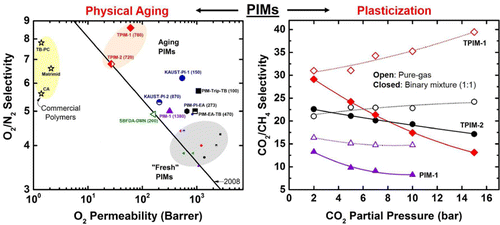当前位置:
X-MOL 学术
›
Macromolecules
›
论文详情
Our official English website, www.x-mol.net, welcomes your
feedback! (Note: you will need to create a separate account there.)
Physical Aging, Plasticization and Their Effects on Gas Permeation in “Rigid” Polymers of Intrinsic Microporosity
Macromolecules ( IF 5.1 ) Pub Date : 2015-08-29 00:00:00 , DOI: 10.1021/acs.macromol.5b01581 Raja Swaidan 1 , Bader Ghanem 1 , Eric Litwiller 1 , Ingo Pinnau 1
Macromolecules ( IF 5.1 ) Pub Date : 2015-08-29 00:00:00 , DOI: 10.1021/acs.macromol.5b01581 Raja Swaidan 1 , Bader Ghanem 1 , Eric Litwiller 1 , Ingo Pinnau 1
Affiliation

|
Long-term physical aging and plasticization, two mobility-based phenomena that are counterintuitive in the context of “rigid” polymers of intrinsic microporosity (PIMs), were evaluated using pure- and mixed-gas permeation data for representative ladder and semiladder PIMs. PIMs between 1 and 4 years old retained from 10- to 1000-fold higher H2 and O2 permeabilities than commercial membrane materials with similar or higher selectivities. A triptycene-based ladder polymer (TPIM-1) exhibited very large selectivity gains outweighing permeability losses after 780 days, resulting in unprecedented performance for O2/N2 (P(O2) = 61 Barrer, α(O2/N2) = 8.6) and H2/N2 (P(H2) = 1105 Barrer, α(H2/N2) = 156) separations. Interestingly, TPIM-1 aged more and faster than its more flexible counterpart, PIM-1, which exhibited P(O2) = 317 Barrer and α(O2/N2) = 5.0 at 1380 days. Additionally, the more “rigid” TPIM-1 plasticized more significantly than PIM-1 (i.e., TPIM-1 endured ∼93% increases in mixed-gas CH4 permeability over pure-gas values compared to ∼60% for PIM-1). A flexible 9,10-bridgehead (i.e., TPIM-2) mitigated the enhancements induced by physical aging but reduced plasticization. Importantly, intra-chain rigidity alone, without consideration of chain architecture and ultra-microporosity, is insufficient for designing aging- and plasticization-resistant gas separation membranes with high permeability and high selectivity
中文翻译:

固有微孔“刚性”聚合物的物理老化,增塑及其对气体渗透的影响
使用代表梯形和半梯形PIM的纯气体和混合气体渗透数据,评估了长期的物理老化和塑化作用,这两种基于流动性的现象在固有微孔(PIM)的“刚性”聚合物中是违反直觉的。1至4岁之间的PIM的H 2和O 2渗透率比具有相似或更高选择性的市售膜材料高10到1000倍。三萜基梯形聚合物(TPIM-1)在780天后显示出非常高的选择性增益,胜过了渗透性损失,从而导致O 2 / N 2(P(O 2)= 61 Barrer,α(O 2 / N 2))= 8.6)和H 2 / N 2(P(H 2)= 1105 Barrer,α(H 2 / N 2)= 156)分离。有趣的是,TPIM-1的老化时间比其更灵活的同类产品PIM-1更快和更快,PIM-1在1380天时的P(O 2)= 317 Barrer和α(O 2 / N 2)= 5.0。此外,更“刚性”的TPIM-1比PIM-1塑化更显着(即,TPIM-1的混合气体CH 4渗透率相对纯气值提高了〜93%,而PIM-1的〜60%) 。灵活的9,10-桥头堡(即TPIM-2)减轻了由于物理老化而引起的增强,但减少了塑化。重要的是,内单链刚性,不考虑链结构和超微孔性,不足以设计具有高渗透性和高选择性的抗老化和抗塑化气体分离膜
更新日期:2015-08-29
中文翻译:

固有微孔“刚性”聚合物的物理老化,增塑及其对气体渗透的影响
使用代表梯形和半梯形PIM的纯气体和混合气体渗透数据,评估了长期的物理老化和塑化作用,这两种基于流动性的现象在固有微孔(PIM)的“刚性”聚合物中是违反直觉的。1至4岁之间的PIM的H 2和O 2渗透率比具有相似或更高选择性的市售膜材料高10到1000倍。三萜基梯形聚合物(TPIM-1)在780天后显示出非常高的选择性增益,胜过了渗透性损失,从而导致O 2 / N 2(P(O 2)= 61 Barrer,α(O 2 / N 2))= 8.6)和H 2 / N 2(P(H 2)= 1105 Barrer,α(H 2 / N 2)= 156)分离。有趣的是,TPIM-1的老化时间比其更灵活的同类产品PIM-1更快和更快,PIM-1在1380天时的P(O 2)= 317 Barrer和α(O 2 / N 2)= 5.0。此外,更“刚性”的TPIM-1比PIM-1塑化更显着(即,TPIM-1的混合气体CH 4渗透率相对纯气值提高了〜93%,而PIM-1的〜60%) 。灵活的9,10-桥头堡(即TPIM-2)减轻了由于物理老化而引起的增强,但减少了塑化。重要的是,内单链刚性,不考虑链结构和超微孔性,不足以设计具有高渗透性和高选择性的抗老化和抗塑化气体分离膜





















































 京公网安备 11010802027423号
京公网安备 11010802027423号